Custom Design
Have you ever spent days working on what you believed was genius content, only to see it vanish into cyberspace with a whopping zero organic visitors? You are not the only one. Most business owners have difficulty making SEO content that does work—content search engines can locate and rank while actually engaging real individuals who stop by your site.
The challenge is no longer about filling your content with keywords these days. Search engines are incredibly advanced at recognizing context, intent, and content quality. Your own audience, in the meantime, has acquired a near-supernatural capacity for recognizing and leaving behind content that reads as robotic or useless in a matter of seconds.


SEO content is the tactical point of convergence where search engine optimization and good information creation cross paths. Instead of thinking of it as keyword-stuffed copy created solely to rank, consider SEO content to be intentional communication that informs search engines about what you’re providing while actually providing real value to the individuals who discover you.
At its core, good SEO content targets specific search intent while still allowing for the natural flow and interest that maintains engagement and keeps readers interested. This implies a grasp of not only what individuals are searching for, but also why they are looking and what they expect to achieve once they find your content.
The business effect goes well beyond mere visibility. When your content properly bridges the gap between what the algorithms demand and what the people need, it becomes a powerful tool that draws qualified leads, establishes trust with potential clients, and places your brand as an informed authority in your niche. This double optimisation strategy directly feeds business growth by having your content draw the right individuals and engage them long enough to consider your services.
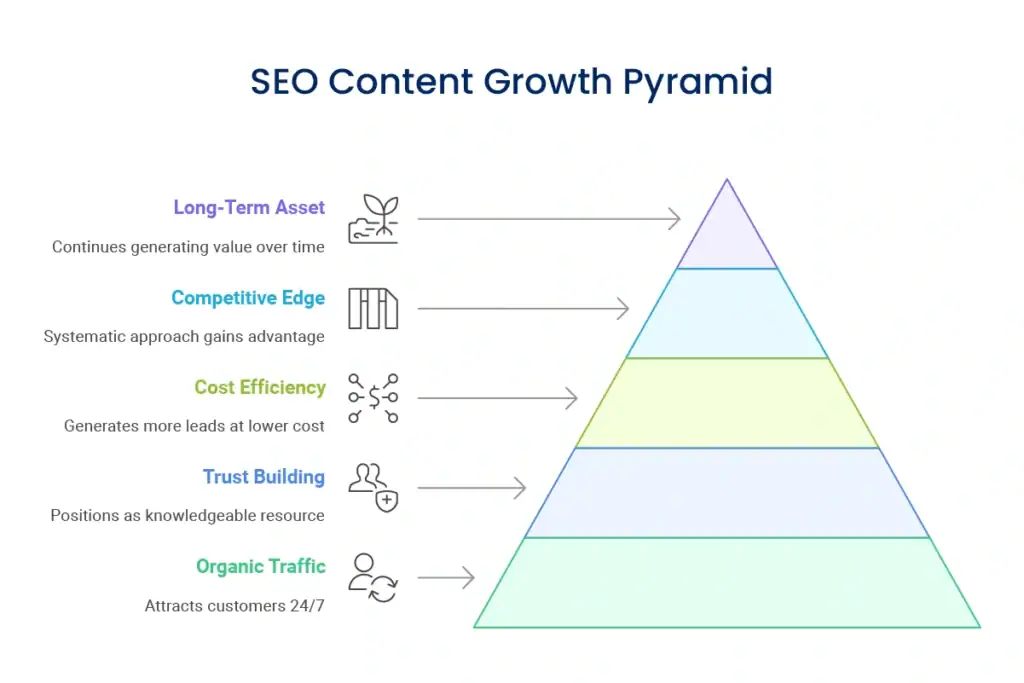
Understanding why SEO content deserves your attention goes beyond simple rankings—it’s about creating sustainable business growth through strategic communication.
Properly written SEO content is like having a 24/7 salesperson who keeps drawing in potential customers who are actively looking for your solutions. Paid advertising ceases to work the instant you discontinue the payment process, but quality content snowballs over time.
When individuals find your content in search and discover it to be truly helpful, you start establishing trust before they even realize your business name. This makes you a learned resource and not just another supplier who competes on price.
In contrast to other forms of advertising, content marketing is 62% cheaper than paid advertising but produces three times as many leads. For small businesses with tight budgets, this cost-effectiveness can be the difference between profitable growth and continuous financial strain.
Most companies either ignore content altogether or do it in a wildabout manner. By creating a methodical approach to SEO content, you are way ahead of competitors who have not taken the time to grasp this strategic method.
Writing content for both algorithms and humans necessitates the understanding that these two groups of people think and judge differently.

Search engines judge content on technical factors that assist them in grasping relevance and quality. These systems search for evident topic signals, coherent content structure, and thorough coverage of topics. They examine how your content aligns with search intent and whether or not it supplies depth and breadth searchers typically need.
The algorithmic assessment also takes technical points such as page loading, mobile-friendliness, and how the users engage with your content after they’ve reached it into account. These signals determine whether your content should rank for particular queries or not.
Humans, however, make instant judgments on whether your content is worth their attention. They read headlines, determine if the introduction speaks to their individual needs, and make an instant decision if reading on will enable them to achieve what they want.
Human interaction is greatly reliant on emotional resonance, utility, and the capacity to readily glean useful information. Individuals desire content that addresses their unique scenario and offers actionable advice they can apply immediately.
The best SEO content arises when these two groups of needs coincide in a natural way. This is when you write in a way that effectively addresses user needs while respecting the technical optimisation best practices. The secret is realising that both audiences really desire the same thing: quality, well-structured information that satisfies certain needs or questions.
Constructing material that meets both the needs of search engines and human readers involves an organized process that fulfills each’s needs without sacrificing the other’s demands.
All of your content must start with a good understanding of why individuals search for your target subjects. Search intent will usually fall within four groups: informational (learning), navigational (look for a specific page), commercial (doing research on a purchase), and transactional (ready to make a purchase).
Aligning your content to specific types of intent guarantees you’re serving up what searchers truly desire instead of what you think they require. This maps directly to both ranking potential as well as user satisfaction since search engines have become incredibly effective at matching content to intent.
Instead of writing individual pieces of content in isolation, build topic clusters that show mastery across your area of expertise. To do this, produce pillar content that addresses large areas comprehensively, backed up by more specific pieces that drill down into specific aspects.
Such an approach enables search engines to comprehend the scope of your know-how while providing readers with multiple touchpoints with your brand throughout various stages of their journey. The interlinking characteristic of clustered content also assists in the content marketing strategies that propel long-term business expansion.
Technical perfection benefits human experience when applied with care. Quick pages, legible navigation, and mobile usability don’t merely meet algorithmic demands—yielding smooth experiences that engage individuals with your content.
This involves structuring content for scanability, employing clear headings to guide readers to appropriate sections of content efficiently, and making the most essential information conspicuous enough to grab attention before users make a decision about whether they want to continue or depart.
Both search engines and readers appreciate content that fully explores topics without wasting space. That is, discussing subjects with sufficient insight to be truly helpful while staying centered on what’s most important to your audience.
Extended coverage doesn’t always equal longer content—it equals covering the entire reach of what a person must know about a subject to act upon it. This strategy establishes trust with readers while showing topical expertise to search engines.
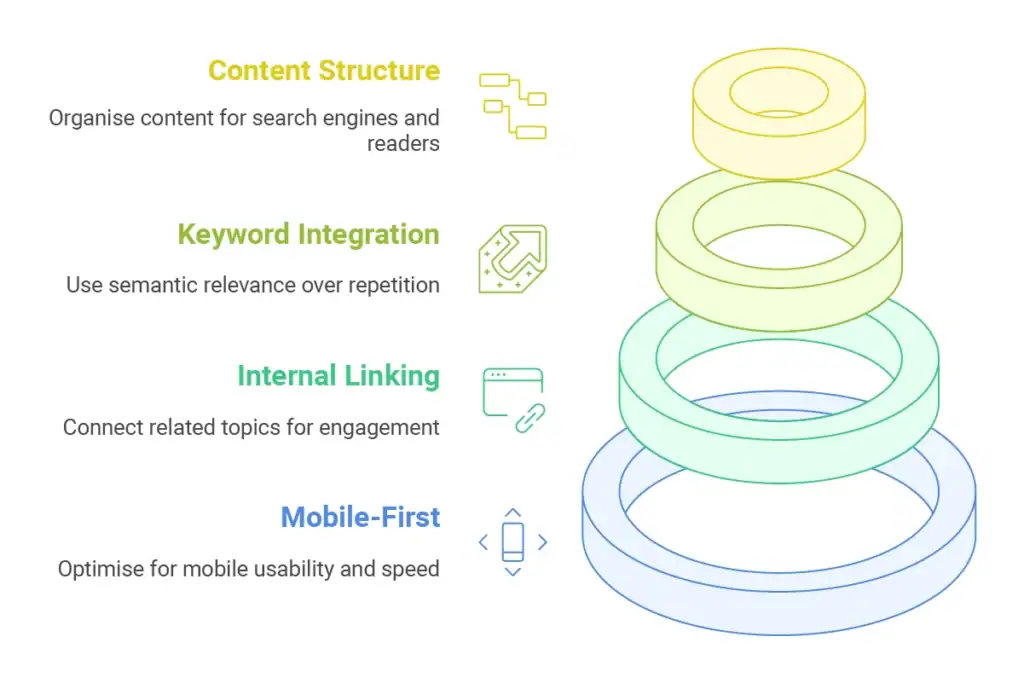
The best SEO content natively marries technical optimisation with human-centered design, and produces experiences that naturally feel while satisfying algorithmic needs.
Correct heading structure (H1, H2, H3) has two purposes: assisting search engines in comprehension of content structure and facilitating easier reading for visitors as they scan and jump to sections that are relevant to them. The hierarchical structure directs both algorithmic crawling and human focus towards keeping important information accessible.
The most effective strategy in keyword inclusion is semantic relevance over exact repetition of phrases. This implies using synonyms, related terms, and contextual variations that naturally come into play when a subject is discussed in detail.
Strategic internal linking allows search engines to better comprehend your site structure while also giving readers clear paths to other related information. This enables deeper engagement while dispersing ranking authority across your site.
Because everyone accesses content on their phones these days, mobile optimisation isn't simply a technical imperative—it's a matter of human usability. That means making sure text can be read without having to zoom in, buttons big enough to easily tap, and navigation that doesn't break on small screens.
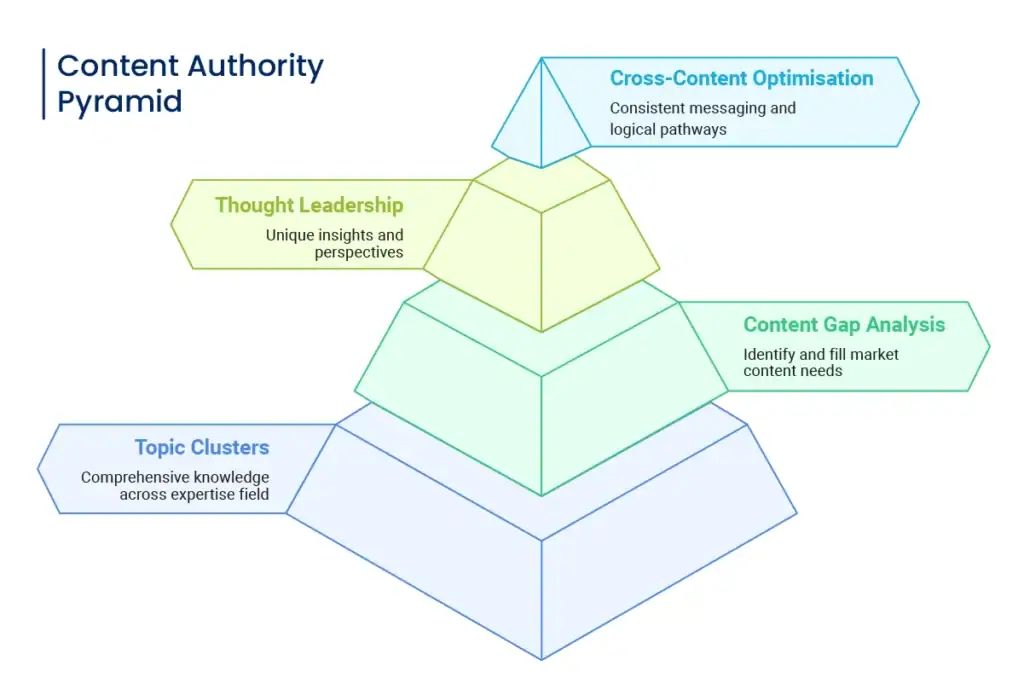
The best SEO content natively marries technical optimisation with human-centered design, and produces experiences that naturally feel while satisfying algorithmic needs.
Establishing authority involves showing mastery of a broad range of topics in your area of expertise. Topic cluster approach entails producing pillar content that addresses broad topics in-depth, supplemented by more niche pieces that delve into specific aspects in depth.
This method makes it easier for search engines to comprehend the range of your expertise while offering potential clients several chances to find and connect with your knowledge. Each work in a cluster reinforces the others, forming a web of content which accumulates authority.
Knowing what your competitors lack enables you to produce content that addresses real needs in your industry. Content gap analysis is about discovering topics which your audience is searching for but not properly covered by current content.
This approach assists you in finding opportunities to rank for high-value terms while actually fulfilling the needs of your audience. By filling gaps that others have ignored, you become the source that others go to for particular information in your industry.
Authority content transcends simple answers to frequently asked questions to provide original insights and points of view that individuals can’t get anywhere else. This could involve relaying case studies from your own experience, providing frameworks you’ve created, or offering analysis that enables individuals to grasp trends within your field.
Thought leadership content tends to rank well in search engines since it offers distinctive value that individuals wish to reference and share. Such content aligns with brand development strategies that establishes you as an industry specialist and not merely another service provider.
Every piece of content must contribute towards your content strategy in its entirety while being useful on its own. This requires ensuring that individual content pieces work towards larger business objectives while satisfying specific search intent.
Cross-content optimization involves applying consistent messaging and terminology that supports your brand positioning, building reasonable pathways among corresponding pieces, and making sure that your content as a whole speaks to a clear narrative about your expertise and methodology.
Producing content that pleases search engines as well as human beings is a structured process that tackles each step of the content creation process.
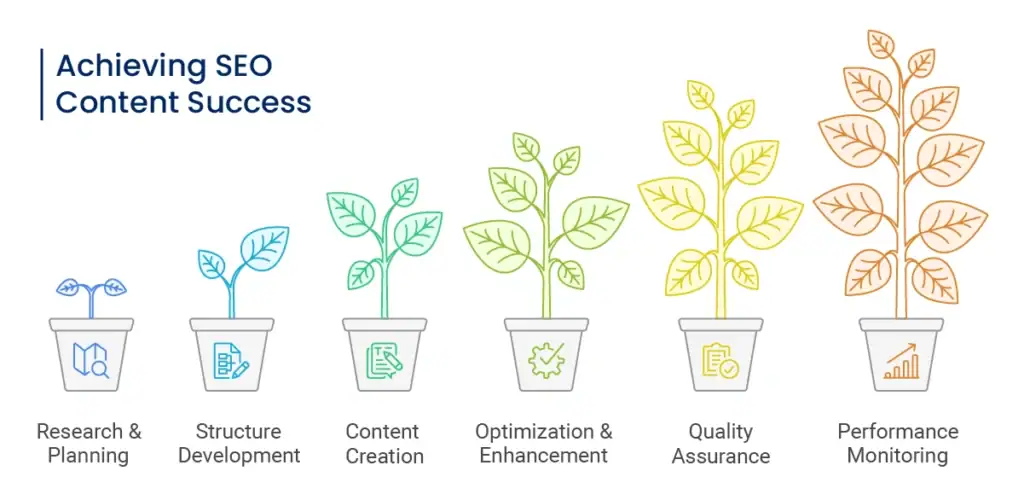
Start by discovering the precise search terms your intended audience utilizes in seeking information connected with your specialty. This extends beyond straightforward industry jargon to encompass the terminology individuals truly employ when they describe their issues or objectives.
Use keyword research tools to know about search volume and competition, but do not ignore the intent behind varying searches. A person looking for “how to raise brand recognition” needs something different than a person looking for “brand recognition strategies,” even though the themes are very much related.
Examine the content that is currently ranking for your target keywords to see what search engines regard as comprehensive coverage. Identify gaps in current content where you can add further value or different insights not yet covered.
Develop a comprehensive outline that covers the entire extent of what searchers must know on your subject. This should cover not only the self-evident facts, but the background and context that inform individuals why the facts are relevant and how to effectively utilize them.
Organize your outline in accordance with the way people really read online. Readers typically scan before they read, so make sure that your headings and subheadings convey worth even to someone who’s rapidly scrolling through your text.
Organize your keyword inclusion in the outlining stage and not attempt to insert keywords post-write. This helps your target words come out organically in situations where they provide value and not in a forced or redundant way.
Write for your human readers as the main priority, that each section adds real value to someone who is attempting to address a problem or discover something new. Prioritize clarity, real-world application, and step-by-step advice that individuals can apply straight away.
Weave your target keywords in naturally while explaining concepts, responding to questions, and offering guidance. The aim is natural integration that improves without interrupting the flow of reading.
Add concrete examples, case studies, or scenarios that enable readers to grasp how they can use what you’re sharing. These specifics tend to be the most memorable and re-shareable aspects of your content.
Check your content for ensuring it covers the entire search intent behind your target keywords. That may involve including additional sections that address related questions or concerns naturally asked when individuals are researching your subject matter.
Optimize your title tags and meta descriptions so that they represent your content accurately while inviting clicks from search results. These need to promise value that your content provides.
Insert internal links that offer logical next steps for readers while making it easier for search engines to comprehend how your content relates to your wider expertise. Use links that truly assist readers instead of trying to insert non-value links.
Prior to publishing, examine your content from technical and human angles. Ensure it loads well, works well on mobile phones, and contains all the technical requirements for search optimization.
Read your content as if you are someone who is first encountering your brand. Does it clearly answer questions? Is it simple to read? Does it offer sufficient value to offset the amount of time someone will spend reading it?
Consider having someone else read your content to see if there are places where further explanation would be useful or where the flow could be tightened for improved readability.
Set up mechanisms for monitoring how your content fares in search engine results and user interaction metrics. This can entail tracking ranks for your focus keywords, as well as others such as time spent on page, scroll depth, and conversion rates.
Establish notifications or frequent check-ins to measure performance and address areas of improvement. Content optimization is an ongoing activity instead of a one-time task.
Schedule updates to content and refinement based on performance metrics and shifting search patterns. The most effective SEO content changes over time to remain relevant and effective.
Google Keyword Planner gives baseline information regarding search volume and competition, albeit more geared towards paid promotion. For content creation, Ubersuggest or Answer The Public are useful for seeing what questions actually get asked on your subjects.
Tools such as Yoast SEO (for WordPress websites) or Surfer SEO assist in comparing your content to ranking criteria while ensuring readability. These sites are able to pick up on areas for improvement without leading to keyword stuffing and other strategies that disadvantage users.
Google Search Console and Google Analytics give you vital information on how well your content ranks in search results and how users engage with it after they visit your site. Both of these tools are free and give you insight into what's working and what is not.
Editorial calendar software assists you to schedule content supporting your overall marketing strategy while maintaining regular publishing schedules. Through this methodical process, it creates momentum and expectations of your audience gradually.
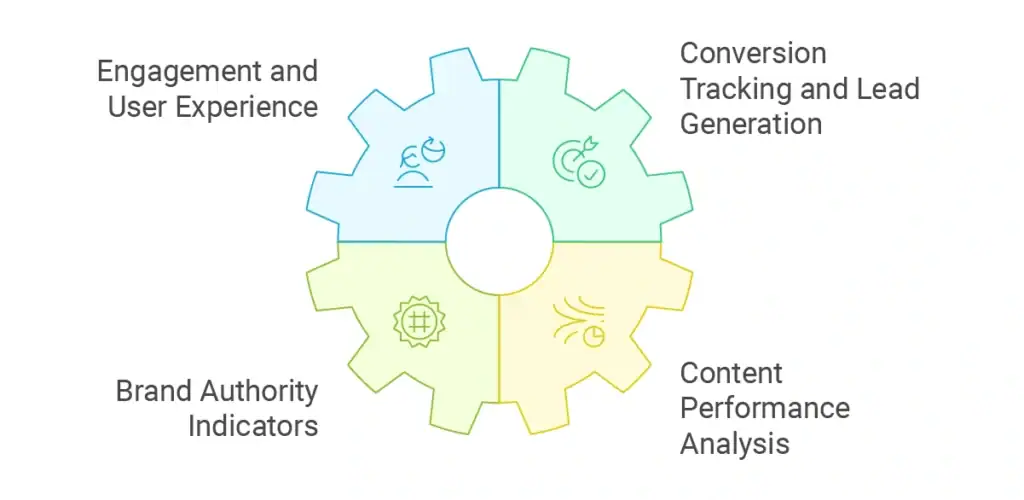
Successful SEO content measurement involves measuring metrics that indicate both search performance and business influence, assisting you in knowing whether your work leads to actual growth.
Monitor how your content drives business objectives beyond the mere attraction of visitors. This could involve newsletter signup, contact form submission, or consultation requests that can be tracked to pieces of content.
Knowing what types of content produce the highest-quality leads allows you to concentrate your efforts on strategies that drive business development instead of merely growing traffic volumes.
Track mentions, backlinks, and social shares that point to your content gaining visibility and credibility in your area of expertise. These indicators tend to be linked to enhanced search performance over time while driving brand awareness objectives directly.
Monitor your content’s performance in terms of creating repeat readers and audience that consistently returns to your site on a regular basis. Long-term business success beyond short-term search visibility is facilitated by this audience building.
Analyze what content types, subjects, and styles produce the highest results for your unique audience and business objectives. This information allows you to adapt your content strategy over time to emphasize what is most effective.
Compare the performance of various content pieces to see what patterns and success factors you can adopt in future content. This iterative improvement process allows your content strategy to become more effective over time.
Succeeding at SEO content that resonates with both algorithms and user interest is one of the most precious business skills of our time. When you accurately fill the void left between technical optimisation and true user value, your content is transformed into an influential tool that draws in qualified leads while establishing sustainable expertise within your niche.
The strategic strategy we’ve outlined—from recognizing dual optimisation needs to developing content architecture that reflects expertise—is a model for developing content that drives sustainable business outcomes. This process-driven approach enables you to step out of the dark arts and build content that performs consistently well in search rankings while actually fulfilling your audience’s needs.
Keep in mind that SEO content excellence is a long-term play and not a short-term solution. Most successful companies treat content creation as a continuing strategic practice that accumulates value in the long run. Every bit of quality content adds to your portfolio of digital assets, and it drives your market position and business success overall.
The companies that succeed know that excellent SEO content isn’t a matter of sacrificing search engine users for human readers—or vice versa—it’s being so good for both that the difference makes no difference. With this balance, your content draws in the right people naturally while creating the authority and credibility that underpins long-term business success.
Creating content that repeatedly draws in qualified leads while establishing real authority is a matter of strategic planning and systematic implementation. If you would like advice on building an SEO content strategy that serves your particular business objectives, discover our in-depth content marketing services or reach out to our staff to learn how strategic content development can fuel your growth.

Enter your email to get instant access